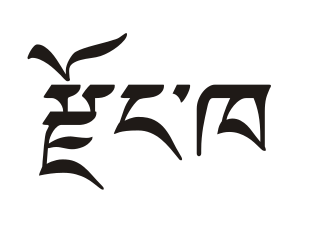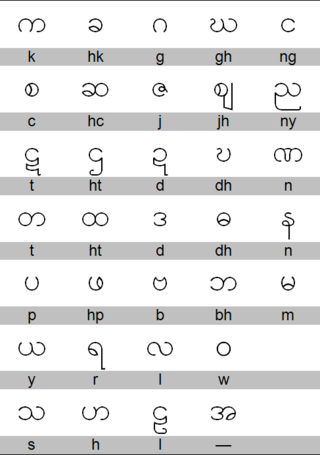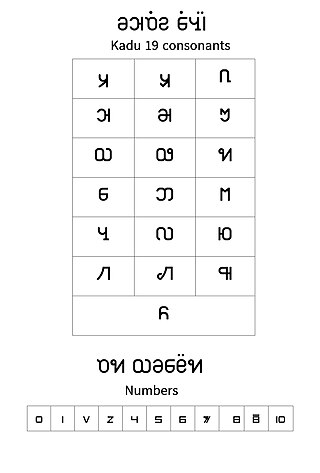Related Research Articles

Sino-Tibetan, also cited as Trans-Himalayan in a few sources, is a family of more than 400 languages, second only to Indo-European in number of native speakers. Around 1.4 billion people speak a Sino-Tibetan language. The vast majority of these are the 1.3 billion native speakers of Sinitic languages. Other Sino-Tibetan languages with large numbers of speakers include Burmese and the Tibetic languages. Other languages of the family are spoken in the Himalayas, the Southeast Asian Massif, and the eastern edge of the Tibetan Plateau. Most of these have small speech communities in remote mountain areas, and as such are poorly documented.

Dzongkha is a Sino-Tibetan language that is the official and national language of Bhutan. It is written using the Tibetan script.

The voiced uvular nasal is a type of consonantal sound, used in some spoken languages. The symbol in the International Phonetic Alphabet that represents this sound is ⟨ɴ⟩, a small capital version of the Latin letter n; the equivalent X-SAMPA symbol is N\.
Khams Tibetan is the Tibetic language used by the majority of the people in Kham. Khams is one of the three branches of the traditional classification of Tibetic languages. In terms of mutual intelligibility, Khams could communicate at a basic level with the Ü-Tsang branch.
Naxi, also known as Nakhi, Nasi, Lomi, Moso, Mo-su, is a Sino-Tibetan language or group of languages spoken by some 310,000 people, most of whom live in or around Lijiang City Yulong Naxi Autonomous County of the province of Yunnan, China. Nakhi is also the ethnic group that speaks it, although in detail, officially defined ethnicity and linguistic reality do not coincide neatly: there are speakers of Naxi who are not registered as "Naxi" and citizens who are officially "Naxi" but do not speak it.

There are approximately a hundred languages spoken in Myanmar. Burmese, spoken by two-thirds of the population, is the official language.

Richard Keith Sprigg was a British linguist who specialised in the phonology of Asian languages. Sprigg was educated under J. R. Firth and was a member of the first generation of professional British linguists. Also as a consequence Sprigg was an advocate of the prosodic phonological method of Firth. Sprigg worked on several Tibeto-Burman languages including Lepcha, and various Tibetan dialects. He taught for many years at the School of Oriental and African Studies, and retired to Kalimpong, West Bengal, India with his wife Ray, granddaughter of David Macdonald the author of The Land of the Lama and 20 Years in Tibet, until her death.
Akha is the language spoken by the Akha people of southern China, eastern Burma, northern Laos, and northern Thailand.
The Sal languages, also known as the Brahmaputran languages, are a branch of Tibeto-Burman languages spoken in northeast India, as well as parts of Bangladesh, Myanmar (Burma), and China.
The Jingpho-Luish, Jingpho-Asakian, Kachin–Luic, or Kachinic languages are a group of Sino-Tibetan languages belonging the Sal branch. They are spoken in northeastern India, Bangladesh and Myanmar, and consist of the Jingpho language and the Luish languages Sak, Kadu, Ganan, Andro, Sengmai, and Chairel. Ethnologue and Glottolog include the extinct or nearly extinct Taman language in the Jingpo branch, but Huziwara (2016) considers it to be unclassified within Tibeto-Burman.

Mru, also known as Mrung (Murung), is a Sino-Tibetan language of Bangladesh and Myanmar. It is spoken by a community of Mrus (Mros) inhabiting the Chittagong Hill Tracts of Bangladesh with a population of 22,000 according to the 1991 census, and in Rakhine State, Myanmar. The Mrus are the second-largest tribal group in Bandarban District of the Chittagong Hill Tracts. A small group of Mros also live in Rangamati Hill District.
The Kadu people are an ethnic group in Myanmar. They speak the Kadu language. They mostly reside in the country's northwestern hills, centred around Katha, and are ethnolinguistically related to the Ganan and Sak peoples. The Kadu traditionally cultivate rice on irrigated terraces.

Kadu or Kado(Kadu:); is a Sino-Tibetan language of the Sal branch spoken in Sagaing Region, Myanmar by the Kadu people. Dialects are Settaw, Mawkhwin, and Mawteik [extinct], with 30,000 speakers total. Kadu is considered an endangered language, and is closely related to the Ganan and Sak languages.
Rawang, also known as Krangku, Kiutze (Qiuze), and Ch’opa, is a Sino-Tibetan language of India and Burma. Rawang has a high degree of internal diversity, and some varieties are not mutually intelligible. Most, however, understand Mutwang (Matwang), the standard dialect, and basis of written Rawang.
Vaiphei is a Sino-Tibetan language belonging to the Kuki-Chin linguistic subbranch of the Tibeto-Burman group of languages. It is spoken mainly in the Myanmar minutely in Manipur-KukiZogam, Mizoram, Assam, Meghalaya, and Tripura. The dialect spoken in Myanmar exhibits a least partial mutual intelligibility with the other Mizo/Kukish dialects of the area including Thadou, Hmar, Paite, Simte, Kom and Gangte languages.
The Luish, Asakian, or Sak languages are a group of Sino-Tibetan languages belonging to the Sal branch. They are spoken in Burma and Bangladesh, and consist of the Sak, Kadu, and Ganan languages. In recent years, Luish languages have been influenced by Burmese and Chakma.

Aimol, also known as Aimual, is a Sino-Tibetan language spoken by the Aimol people of Manipur, India. It is considered endangered and has less than 9,000 speakers worldwide as per 2011 census. The speakers of this language use Meitei language as their second language (L2) according to the Ethnologue.
Ganan is a Sino-Tibetan language of northwestern Myanmar, spoken in Sagaing Region. It belongs to the Luish branch, and is most closely related to the Kadu language of Myanmar, with which it shares 84 to 89% lexical similarity. The Ganan dialects share 95 to 99% lexical similarity.
Taman is an extinct Sino-Tibetan language that was spoken in Htamanthi village in Homalin Township, Sagaing Region, northern Myanmar. It was documented in a list of 75 words in Brown (1911). Keisuke Huziwara (2016) discovered an elderly rememberer of Taman in Htamanthi who could remember some Taman phrases as well as a short song, but was not fluent in the Taman language. However, no fluent speakers of Taman remained in the area.
The Chamdo languages are a group of recently discovered, closely related Sino-Tibetan languages spoken in Chamdo Prefecture, Tibet. Their position within the Sino-Tibetan language family is currently uncertain.
References
- ↑ Sak at Ethnologue (25th ed., 2022)

- ↑ Huziwara, Keisuke (2018). Varieties of Cak dialects. Paper presented at the 28th Annual Meeting of the Southeast Asian Linguistics Society, held May 17-19, 2018 in Kaohsiung, Taiwan.
- ↑ Huziwara, Keisuke (2019). A sketch of Cak grammar. Kyoto: The Hakubi Project of Kyoto University.
- ↑ Huziwara, Keisuke (2002). チャック語の音声に関する考察 [A phonetic analysis of Cak]. 京都大学言語学研究 [Kyoto University Linguistic Research] 21: Kyoto University. pp. 217–273.
{{cite book}}: CS1 maint: location (link) - 1 2 "Chak". lingweb.eva.mpg.de. Retrieved 2024-01-07.
